Qiuyu Wang
Time Is a Feature: Exploiting Temporal Dynamics in Diffusion Language Models
Aug 12, 2025Abstract:Diffusion large language models (dLLMs) generate text through iterative denoising, yet current decoding strategies discard rich intermediate predictions in favor of the final output. Our work here reveals a critical phenomenon, temporal oscillation, where correct answers often emerge in the middle process, but are overwritten in later denoising steps. To address this issue, we introduce two complementary methods that exploit temporal consistency: 1) Temporal Self-Consistency Voting, a training-free, test-time decoding strategy that aggregates predictions across denoising steps to select the most consistent output; and 2) a post-training method termed Temporal Consistency Reinforcement, which uses Temporal Semantic Entropy (TSE), a measure of semantic stability across intermediate predictions, as a reward signal to encourage stable generations. Empirical results across multiple benchmarks demonstrate the effectiveness of our approach. Using the negative TSE reward alone, we observe a remarkable average improvement of 24.7% on the Countdown dataset over an existing dLLM. Combined with the accuracy reward, we achieve absolute gains of 2.0% on GSM8K, 4.3% on MATH500, 6.6% on SVAMP, and 25.3% on Countdown, respectively. Our findings underscore the untapped potential of temporal dynamics in dLLMs and offer two simple yet effective tools to harness them.
Seeing through Satellite Images at Street Views
May 22, 2025Abstract:This paper studies the task of SatStreet-view synthesis, which aims to render photorealistic street-view panorama images and videos given any satellite image and specified camera positions or trajectories. We formulate to learn neural radiance field from paired images captured from satellite and street viewpoints, which comes to be a challenging learning problem due to the sparse-view natural and the extremely-large viewpoint changes between satellite and street-view images. We tackle the challenges based on a task-specific observation that street-view specific elements, including the sky and illumination effects are only visible in street-view panoramas, and present a novel approach Sat2Density++ to accomplish the goal of photo-realistic street-view panoramas rendering by modeling these street-view specific in neural networks. In the experiments, our method is testified on both urban and suburban scene datasets, demonstrating that Sat2Density++ is capable of rendering photorealistic street-view panoramas that are consistent across multiple views and faithful to the satellite image.
Edicho: Consistent Image Editing in the Wild
Dec 30, 2024Abstract:As a verified need, consistent editing across in-the-wild images remains a technical challenge arising from various unmanageable factors, like object poses, lighting conditions, and photography environments. Edicho steps in with a training-free solution based on diffusion models, featuring a fundamental design principle of using explicit image correspondence to direct editing. Specifically, the key components include an attention manipulation module and a carefully refined classifier-free guidance (CFG) denoising strategy, both of which take into account the pre-estimated correspondence. Such an inference-time algorithm enjoys a plug-and-play nature and is compatible to most diffusion-based editing methods, such as ControlNet and BrushNet. Extensive results demonstrate the efficacy of Edicho in consistent cross-image editing under diverse settings. We will release the code to facilitate future studies.
DepthLab: From Partial to Complete
Dec 24, 2024



Abstract:Missing values remain a common challenge for depth data across its wide range of applications, stemming from various causes like incomplete data acquisition and perspective alteration. This work bridges this gap with DepthLab, a foundation depth inpainting model powered by image diffusion priors. Our model features two notable strengths: (1) it demonstrates resilience to depth-deficient regions, providing reliable completion for both continuous areas and isolated points, and (2) it faithfully preserves scale consistency with the conditioned known depth when filling in missing values. Drawing on these advantages, our approach proves its worth in various downstream tasks, including 3D scene inpainting, text-to-3D scene generation, sparse-view reconstruction with DUST3R, and LiDAR depth completion, exceeding current solutions in both numerical performance and visual quality. Our project page with source code is available at https://johanan528.github.io/depthlab_web/.
LeviTor: 3D Trajectory Oriented Image-to-Video Synthesis
Dec 19, 2024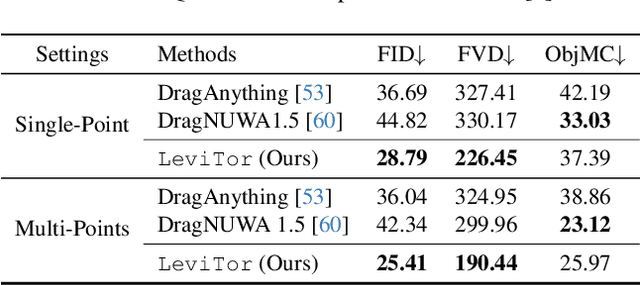
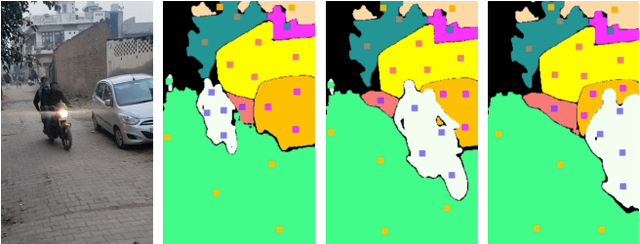
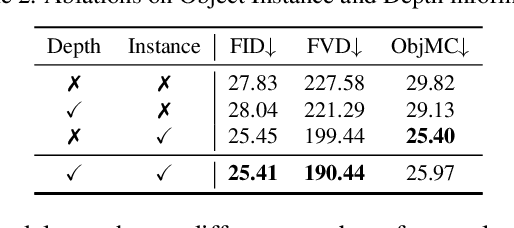
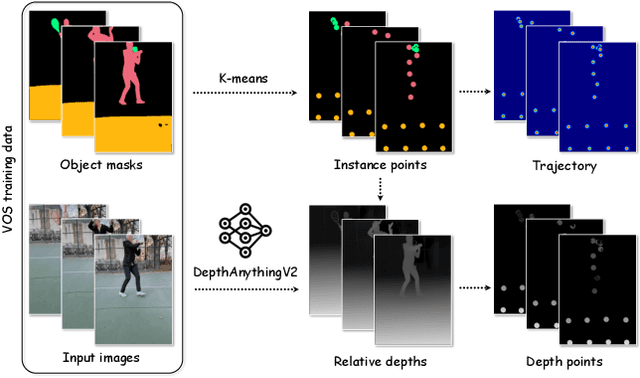
Abstract:The intuitive nature of drag-based interaction has led to its growing adoption for controlling object trajectories in image-to-video synthesis. Still, existing methods that perform dragging in the 2D space usually face ambiguity when handling out-of-plane movements. In this work, we augment the interaction with a new dimension, i.e., the depth dimension, such that users are allowed to assign a relative depth for each point on the trajectory. That way, our new interaction paradigm not only inherits the convenience from 2D dragging, but facilitates trajectory control in the 3D space, broadening the scope of creativity. We propose a pioneering method for 3D trajectory control in image-to-video synthesis by abstracting object masks into a few cluster points. These points, accompanied by the depth information and the instance information, are finally fed into a video diffusion model as the control signal. Extensive experiments validate the effectiveness of our approach, dubbed LeviTor, in precisely manipulating the object movements when producing photo-realistic videos from static images. Project page: https://ppetrichor.github.io/levitor.github.io/
AniDoc: Animation Creation Made Easier
Dec 18, 2024Abstract:The production of 2D animation follows an industry-standard workflow, encompassing four essential stages: character design, keyframe animation, in-betweening, and coloring. Our research focuses on reducing the labor costs in the above process by harnessing the potential of increasingly powerful generative AI. Using video diffusion models as the foundation, AniDoc emerges as a video line art colorization tool, which automatically converts sketch sequences into colored animations following the reference character specification. Our model exploits correspondence matching as an explicit guidance, yielding strong robustness to the variations (e.g., posture) between the reference character and each line art frame. In addition, our model could even automate the in-betweening process, such that users can easily create a temporally consistent animation by simply providing a character image as well as the start and end sketches. Our code is available at: https://yihao-meng.github.io/AniDoc_demo.
MagicQuill: An Intelligent Interactive Image Editing System
Nov 14, 2024Abstract:Image editing involves a variety of complex tasks and requires efficient and precise manipulation techniques. In this paper, we present MagicQuill, an integrated image editing system that enables swift actualization of creative ideas. Our system features a streamlined yet functionally robust interface, allowing for the articulation of editing operations (e.g., inserting elements, erasing objects, altering color) with minimal input. These interactions are monitored by a multimodal large language model (MLLM) to anticipate editing intentions in real time, bypassing the need for explicit prompt entry. Finally, we apply a powerful diffusion prior, enhanced by a carefully learned two-branch plug-in module, to process editing requests with precise control. Experimental results demonstrate the effectiveness of MagicQuill in achieving high-quality image edits. Please visit https://magic-quill.github.io to try out our system.
Framer: Interactive Frame Interpolation
Oct 24, 2024
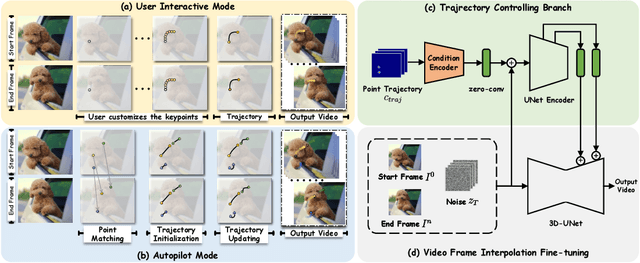


Abstract:We propose Framer for interactive frame interpolation, which targets producing smoothly transitioning frames between two images as per user creativity. Concretely, besides taking the start and end frames as inputs, our approach supports customizing the transition process by tailoring the trajectory of some selected keypoints. Such a design enjoys two clear benefits. First, incorporating human interaction mitigates the issue arising from numerous possibilities of transforming one image to another, and in turn enables finer control of local motions. Second, as the most basic form of interaction, keypoints help establish the correspondence across frames, enhancing the model to handle challenging cases (e.g., objects on the start and end frames are of different shapes and styles). It is noteworthy that our system also offers an "autopilot" mode, where we introduce a module to estimate the keypoints and refine the trajectory automatically, to simplify the usage in practice. Extensive experimental results demonstrate the appealing performance of Framer on various applications, such as image morphing, time-lapse video generation, cartoon interpolation, etc. The code, the model, and the interface will be released to facilitate further research.
InFusion: Inpainting 3D Gaussians via Learning Depth Completion from Diffusion Prior
Apr 17, 2024



Abstract:3D Gaussians have recently emerged as an efficient representation for novel view synthesis. This work studies its editability with a particular focus on the inpainting task, which aims to supplement an incomplete set of 3D Gaussians with additional points for visually harmonious rendering. Compared to 2D inpainting, the crux of inpainting 3D Gaussians is to figure out the rendering-relevant properties of the introduced points, whose optimization largely benefits from their initial 3D positions. To this end, we propose to guide the point initialization with an image-conditioned depth completion model, which learns to directly restore the depth map based on the observed image. Such a design allows our model to fill in depth values at an aligned scale with the original depth, and also to harness strong generalizability from largescale diffusion prior. Thanks to the more accurate depth completion, our approach, dubbed InFusion, surpasses existing alternatives with sufficiently better fidelity and efficiency under various complex scenarios. We further demonstrate the effectiveness of InFusion with several practical applications, such as inpainting with user-specific texture or with novel object insertion.
Uncertainty-driven and Adversarial Calibration Learning for Epicardial Adipose Tissue Segmentation
Feb 23, 2024
Abstract:Epicardial adipose tissue (EAT) is a type of visceral fat that can secrete large amounts of adipokines to affect the myocardium and coronary arteries. EAT volume and density can be used as independent risk markers measurement of volume by noninvasive magnetic resonance images is the best method of assessing EAT. However, segmenting EAT is challenging due to the low contrast between EAT and pericardial effusion and the presence of motion artifacts. we propose a novel feature latent space multilevel supervision network (SPDNet) with uncertainty-driven and adversarial calibration learning to enhance segmentation for more accurate EAT volume estimation. The network first addresses the blurring of EAT edges due to the medical images in the open medical environments with low quality or out-of-distribution by modeling the uncertainty as a Gaussian distribution in the feature latent space, which using its Bayesian estimation as a regularization constraint to optimize SwinUNETR. Second, an adversarial training strategy is introduced to calibrate the segmentation feature map and consider the multi-scale feature differences between the uncertainty-guided predictive segmentation and the ground truth segmentation, synthesizing the multi-scale adversarial loss directly improves the ability to discriminate the similarity between organizations. Experiments on both the cardiac public MRI dataset (ACDC) and the real-world clinical cohort EAT dataset show that the proposed network outperforms mainstream models, validating that uncertainty-driven and adversarial calibration learning can be used to provide additional information for modeling multi-scale ambiguities.
 Add to Chrome
Add to Chrome Add to Firefox
Add to Firefox Add to Edge
Add to Edge